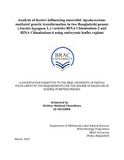Analysis of factors influencing successful Agrobacterium-mediated genetic transformation in two Bangladeshi peanut (Arachis hypogaea L.) varieties BINA Chinabadam-2 and BINA Chinabadam-6 using embryonic leaflet explant

View/Open
Date
2014-03Publisher
BRAC UniversityAuthor
Chowdhury, Iftekhar MahmudMetadata
Show full item recordAbstract
Peanut (Arachis hypogaea L.) is an important crop both for its nutritional value and for its oil content in the seeds. But this economically important crop is susceptible to both biotic and abiotic factors that hamper its growth both in quality and quantity. Due to change in agricultural environment and also due to lack of resistance towards diseases the production is compromised. For this reason, genetic engineering is a possible tool to enhance the quality of the crop by introducing novel trait in it. To achieve that it a prerequisite to established a transformation protocol prior to any transformation event. Establishment of an efficient Agrobacterium-mediated transformation protocol requires optimization of several factors that affects the transfer of T-DNA. In the present study, these were optimized for two peanut varieties, namely, BINA Chinabadam 2, and BINA Chinabadam 6 using embryonic leaflet as a source of explant. In this study, Agrobacterium tumifaciens strain LBA4404 carrying pBI121 having GUS and nptII marker genes was used. T-DNA transfer was monitored through transient transformation assay utilizing GUS gene expression. Bacterial suspension having density (OD600) more than 1.0 with at least 1 hour of incubation period and minimum of 2 days of co-cultivation period found to be
efficient for leaflet explants in both the varieties. Following transfer of T-DNA, presence of transgene within the infected tissue was observed by GUS histochemical transient assay.
